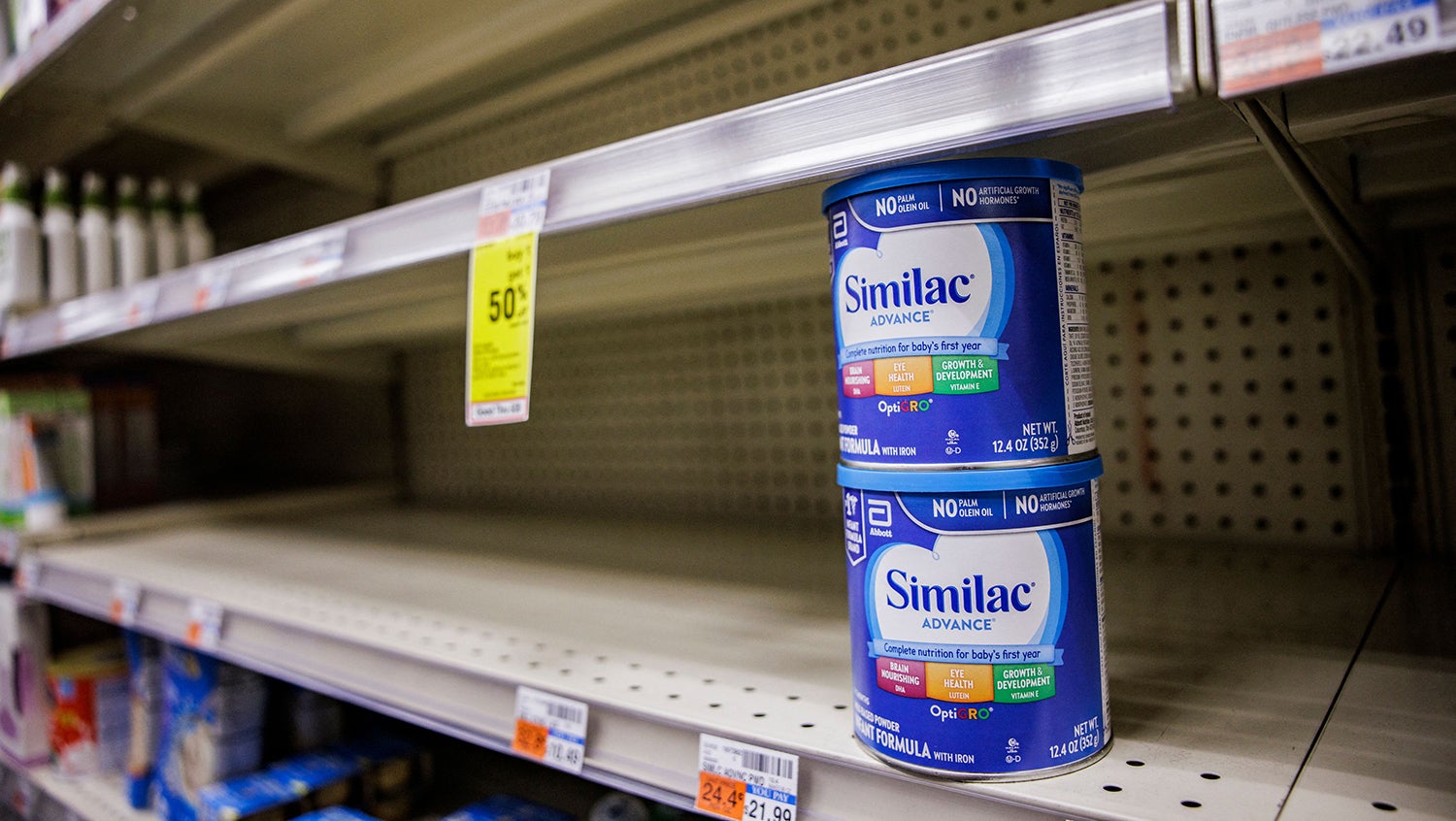U.S. Formula Shortage Exposes Deep-Rooted Injustices Across Industries
September 29, 2022
By Neha S. Anand, MD MPH, By Jessica Gregory, MD, By Nguyen Lu, MD, By Rita Wang, MD

Samuel Corum, Getty Images
The infant formula shortage has impacted all babies who need it, but families who access WIC programs bear the brunt.
In February 2022, Abbott, the predominant infant formula manufacturer in the United States, shut down its main factory, which produces nearly half of its formula supply, due to recalls on its powdered Similac formula. By the start of July, the Abbott factory slowly reopened, but the damage was already done. Parents have been reeling as the formula shortage has persisted, searching market after market for formula with shelves slowly emptying out. While the shortage was initiated by one factory closure, the root cause has a much more complex and multisystem history.
Infant formula industry as big business
In a society where bottle feeding has become a cultural norm — with inadequate support for breastfeeding or chestfeeding — infant formula manufacturing has become a big business. Currently, 98% of the formula consumed by infants in the U.S. is manufactured in the this country. Furthermore, 90% of the U.S. formula market is dominated by only four major production companies.
In recent years, formula companies have developed increasingly lean production systems, using birthrate data alongside buying patterns to predict how much formula to produce at any given time. These data help optimize operations to be as lean and efficient as possible, which is helpful for the bottom line, but gives little room for fluctuating needs.
Another factor leading to the shortage has been the COVID pandemic, as waves of workers have been out sick and supply chains have weakened. At the same time, many families worried about stock were pushed to purchase in bulk. Moreover, infant formula companies and others have communicated breastfeeding risks that were not based on evidence and oppose recommendations from the WHO, which has continued to encourage skin-to-skin and breastfeeding in the pandemic.
The resulting shortage has affected formula-using families across the U.S., but the impact has not been equal. There are major inequities in formula access, which have been exacerbated by the current shortage.
Families using the WIC program face unique challenges
Low-income families, specifically families that participate in the special supplemental nutrition program for Women, and Infants and Children (WIC), have particularly felt the sting of this formula shortage. The federal organization serves more than 40% of infants, who are responsible for more than 50% of formula consumption.
Though many low-income families receive support from WIC, there are substantial barriers to WIC enrollment and access, including income eligibility, transportation to appointments, long wait times, and language and cultural barriers. To exacerbate these obstacles, eligibility changes from state to state. And even once WIC benefits are obtained, barriers still exist, including the distance to stores that accept WIC benefits, as well as the inability to buy formula online.
There are even fewer formula companies for WIC customers: Abbott, Mead Johnson, and Nestle Gerber. However, this doesn’t necessarily mean that families can use their WIC benefits to freely choose which of these brands they want to purchase. Access depends on where you live.
In order to determine which brands WIC will pay for, the agency engages in a process called “competitive bidding” with the formula manufacturers. This process happens in every state and involves multiple manufacturers competing to be the state’s sole contractor for WIC. In return for the sole contract, the manufacturer provides rebates to WIC on formula. This effectively creates a monopoly of one infant formula contractor for the entire state. The monopoly can leave WIC recipients particularly vulnerable to shortages and recalls, as WIC only reimburses for the formula supplied by the sole contractor, unless a recipient has a medical waiver for another type of formula.
Because Abbott is the sole contractor for WIC in much of the U.S., shutdown of the Abbott factory disproportionately affected WIC recipients, at least initially. Even in states where Abbott was not the sole contractor, panic-buying led to other manufacturers’ formulas being hard to find, too — a difficulty compounded for WIC recipients as, again, their benefits could only be used for formula supplied by their state’s sole contractor.
How inequities in human milk provision and lactation support impact the formula shortage
Given the American Academy of Pediatrics’ recommendation for exclusive feeding with human milk for the first six months of life, it is important to discuss how disparities in human milk provision and lactation support play into the formula shortage.
Data from the CDC on breastfeeding shows clear disparities in the proportion of infants who are ever breastfed, with Black infants initiating breastfeeding at substantially lower rates. Even though rates of breastfeeding initiation have been slowly increasing over time, the gap between Black infants and other racial/ethnic groups appears to be persistent. Breastfeeding rates tend to decline as infants age, but at faster rates for Black and nonwhite Hispanic populations than for their white and Asian counterparts.
Data also show differences in breastfeeding based on income. There are significantly decreased rates in exclusive breastfeeding at three months for those families living less than 200% below the poverty line.
Obviously, infants who in some way rely on formula are more significantly affected by the shortage than those who are exclusively receiving human milk. But why do such disparities exist?
Like many health disparities, the ability to breastfeed or chestfeed is influenced by factors at many levels: individual, community, workplace, and systemic.
At the individual level, personal and cultural beliefs influence feeding practices. As we know, breast or chestfeeding can be exhausting and time-consuming, making it more difficult for parents who are caretakers of multiple children or family members, those who work outside the home, and those who have less social support.
It is also important to consider some populations where breast or chestfeeding is more difficult to achieve. Children with medical complexity may require liquid nutrition past the point where a parent would be able to maintain adequate milk supply. Chronically ill parents may have more difficulty with producing milk or have contraindications related to their own necessary medications or other health concerns. Adopted children or children in foster care may not have access to a lactating parent. Children of LGBTQ+ parents may not have a lactating parent at home or may have a parent who has undergone gender-affirming care that makes lactation difficult.
“Baby E” was born amidst the ongoing formula shortage. Already born into a family facing multiple systemic barriers, Baby E’s early life was made more complicated by an extended stay in the NICU that necessitated a specialized formula. Click here to read more about how the shortage impacted this family.
At the community level, there are discrepancies in who is offered lactation support. A North Carolina study found that counties with a higher composition of Black residents had less access to lactation support services. Black families are also more likely to be offered formula in the hospital, one of the strongest predictors of who will not go on to breast or chestfeed. Lack of in-hospital lactation supports disproportionately affects first-time parents, those with fewer social supports, and those who have more difficulty accessing these supports on their own, after leaving the hospital.
At a systemic level, a lack of federally mandated parental leave means that many lactating parents are forced to be separated from their infants to return to work, making it more difficult to sustain exclusive human milk provision. Differences in insurance providers also dictate which families have access to pumps and other lactation supplies.
The workplace can also present barriers to exclusive feeding with human milk, based on who is offered the time and space to take time to pump and store milk. Low-income parents are more likely than their higher income counterparts to return to work earlier and to be engaged in jobs that make it challenging for them to continue lactation. Supportive workplace environments are less likely to be accessible to parents who are not able to work from home, especially those working in the service industry, and those working multiple jobs.
Another systemic factor is that the U.S. is one of a few countries that has not adopted the WHO international code of marketing, which prohibits marketing formula. This means that formula companies can market their products to families, which can lead to false perceptions around infant feeding practices that discourage families from using human milk.
What can providers do to mitigate the impacts of the infant formula shortage?
As healthcare providers, we need to acknowledge the structural racism that underlies existing inequities in lactation practices, as well as infant formula access. In the short term, we must continue to provide lactation support in our clinical settings and anticipate that families will need enhanced assistance with WIC enrollment. We should also advocate with WIC for coverage of alternative formulas and provide case management assistance for families who access formula via durable medical equipment (DME) suppliers.
In the longer term, we must advocate for policies to increase equitable lactation support, such as paid parental leave, baby-friendly hospital practices, adequate lactation spaces in diverse workplaces, and affordable access to donor milk.
Advocacy for structural change, including strengthening the WIC program, is vital to support families and promote more reliable infant formula access. For example, we can advocate for a bill introduced in July 2022, to the House of Representatives, for WIC reauthorization as part of the Healthy Meals, Healthy Kids act, that aims to enhance and modernize WIC. The bill includes provisions such as expanding online and mobile payments for WIC, increasing funding for its lactation support services, allowing collaboration with smaller formula businesses, and the automatic certification of newborns into the WIC program.
Overall, systemically rooted injustices disproportionately impact people of color and their access to formula as well as lactation support. It is time for healthcare providers to push for change.
This story was adapted from a presentation at the September 2022 Health Equity Rounds. Katherine Douglas, MD, Heather Hsu, MD MPH, and Alexandra Pottorff, MD, also contributed.


